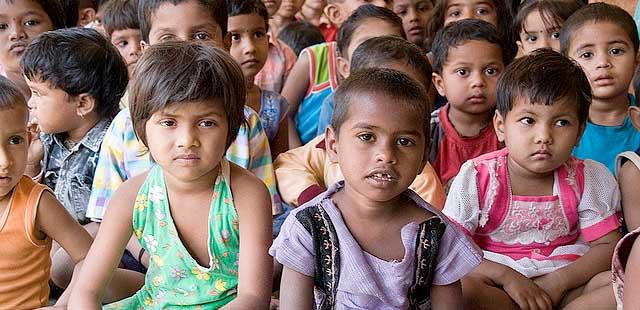India’s Bias for Boys
School children in India (Photo: Dey Alexander)
By Hanna Ingber Win
Forty miles outside Mumbai stands a large farmhouse painted cream with red trim. Inside, it is airy and welcoming.
Sixteen-year-old Shriti (not her real name) shows me the large terrace, the living room, her bedroom.
“Two girls here, two girls there, and my mom and dad sleep in the living room,” she says.
Shriti is one of four girls. She has no brothers.
That is unusual in India. According to the most recent census, the country has far more boys than girls.
Public health experts say the skewed sex ratio is the result of an illegal but increasingly common practice, one that Shriti’s parents engaged in while attempting to have a son. It is a practice few talk about openly.
A Preference for Boys
Shriti’s father — we’ll call him Sanjay — works at a chemical company, where he earns about $5,000 a year. That is a decent middle-class salary here, but it “does not suffice,” Sanjay says.
Having four girls is expensive.
For his first daughter’s wedding, Sanjay spent about $9,000 — almost twice his annual income. (He says it was just your average Indian wedding.) Sanjay plans to take out loans to provide his other three daughters with weddings and possible dowries.
Despite the financial burden, Sanjay says he is content having girls.
“I am happy with what I have,” he says.
But after Sanjay leaves for work, his wife — we’ll call her Anu — has an opportunity to talk. She wears a blue sari, and she has a red bindi on her forehead.
Anu tells a very different story.
“My husband would say, ‘Who will take care of me when I’m old? That’s why you need a son. Girls will get married and go to their husband’s house. Who will take care of us?’ It went on like that, him saying, ‘We want a son, we want a son.'”
Anu says the pressure to have a son grew throughout her marriage. It came from both her husband and her mother-in-law.
So she kept getting pregnant. But with each birth came the bad news: a girl.
Advice from a Gynecologist
When she was pregnant with her fourth child she took some advice from her gynecologist. The doctor told Anu there was a radiologist in a nearby town who could tell her if she was pregnant with a girl or a boy.
It is illegal in India for doctors to tell women the sex of their fetus and for women to have abortions based on that information, but the laws are not enforced, and women can easily find out which clinics break the rules.
Anu went to the radiologist and had an ultrasound done. She waited until the fifth month of her pregnancy because she was under the misimpression that the radiologist could only then make out the fetus’s gender. She returned home with the news.
“I told my family that I was pregnant with a girl,” she says. “So I aborted it.”
Anu got pregnant again and learned it was also a girl. She decided to go through with the birth. That child was daughter Shriti.
Then Anu got pregnant three more times.
“I wanted at least one son — from anywhere — and that’s why I fasted a lot, and I prayed to God,” she says.
But each time, she went to the radiologist and learned the bad news: a girl. She aborted each one.
Anu is now 50 and can no longer get pregnant, but she can’t completely move on. She says the four abortions haunt her.
“I feel a very strong connection to the pregnancies,” she says. “Even now, I remember them all. When I sit doing nothing, I remember them all.”
Now, every time something goes wrong in her life, she thinks she is being punished. When her husband gets sick, she blames the abortions. When she has trouble finding suitable husbands for her daughters, she blames the abortions.
Anu used to pray and ask for a son. Now, she prays and asks for forgiveness.
“I aborted a child,” she says. “I feel I’ve sinned.”
Slowly Changing Attitudes
Anu’s struggles are reflective of what many families in India face. As Indians become more prosperous and have access to technology that can tell them the sex of a fetus, they are increasingly choosing to abort their girls.
Demographers and health activists predict that in time the bias against daughters will fade as women achieve higher education levels and greater status in society.
Anu says she won’t encourage her daughters to have sex selective abortions. She doesn’t want them to go through what she experienced.
And yet, when Anu’s oldest daughter recently gave birth to her first child, Anu was worried that it would be a girl. That would have ruined the marriage prospects for Anu’s other three daughters.
Luckily, for the entire family, she says, it was a boy.
This story was produced in collaboration with Round Earth Media.
